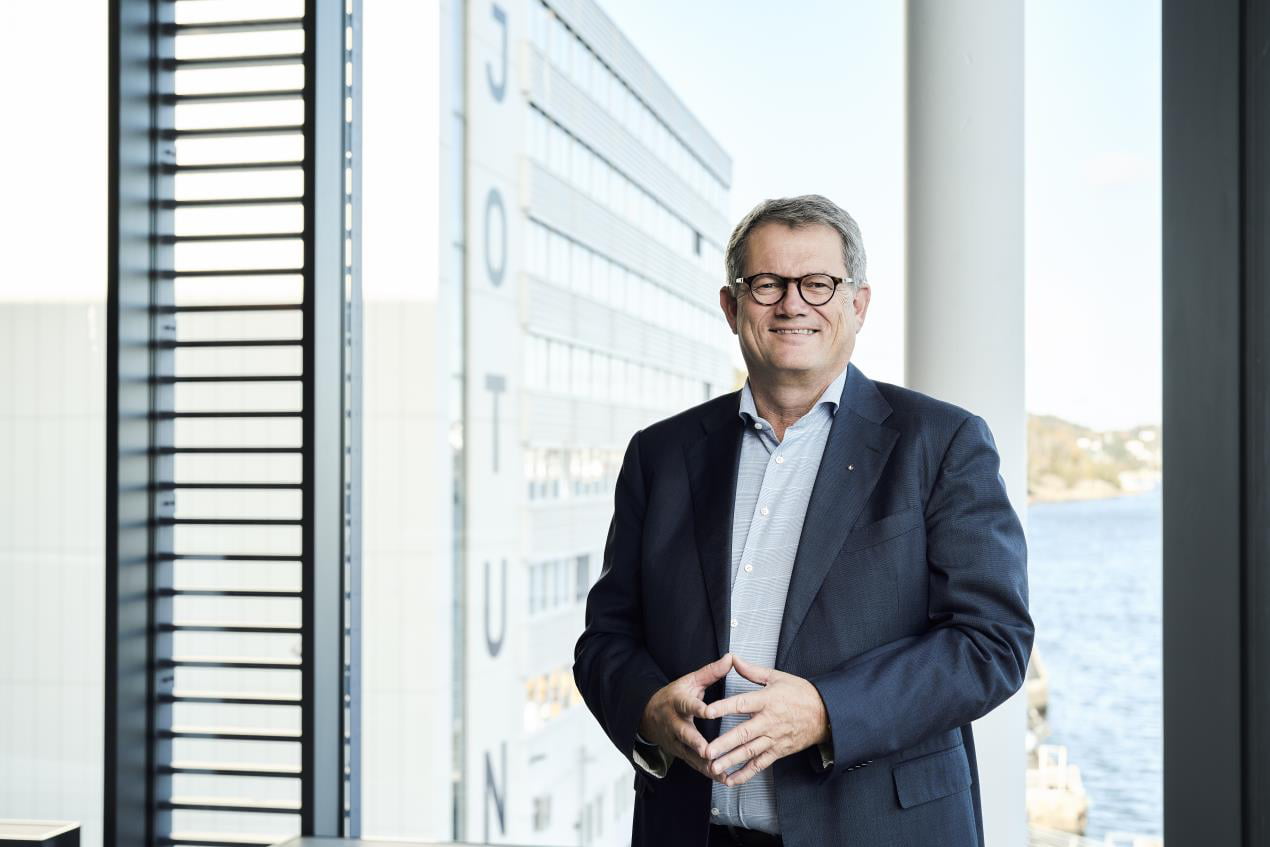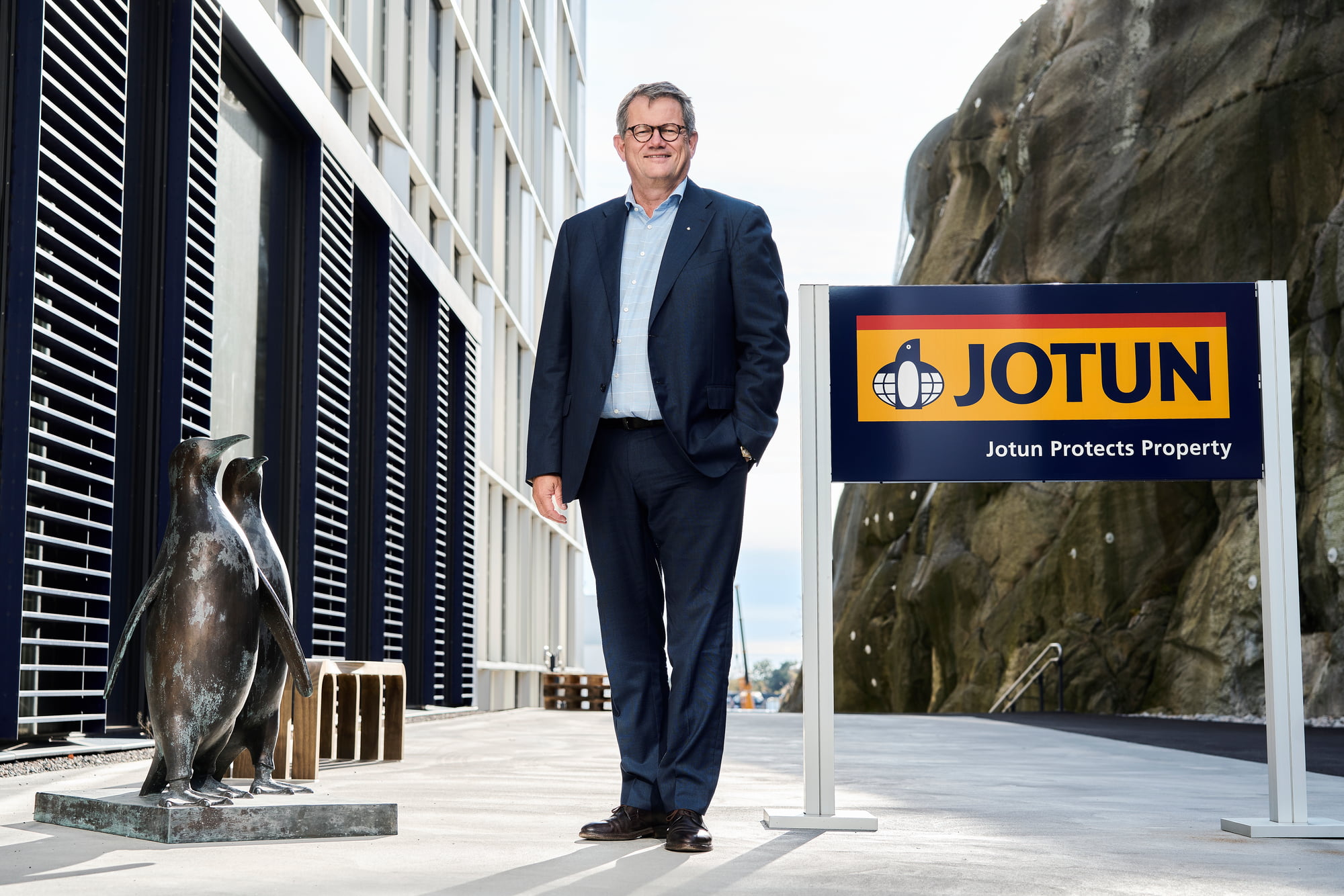As the world’s leading supplier of marine coatings, Jotun partners with a broad range of stakeholders working to decarbonise shipping. But is the industry moving fast enough? Jotun’s President and CEO Morten Fon shares his views on how leadership, innovation and collaboration can accelerate the transition to a low carbon future.
From his corner office on the seventh floor of Jotun’s Headquarters and R&D Centre, Morten Fon, Jotun’s President and CEO, has stunning views of the marine traffic going in and out of the port of Sandefjord, Norway. While the BREEAM-NOR-certified building is new (completed in 2020) Fon’s view would be familiar to the company’s founder, Odd Gleditsch sen., who established the company on the same piece of land in 1926.
“Jotun’s roots in the maritime industry stretch back almost a century, so we have lived through a great many challenges in this highly cyclical industry,” he says. “But in my view, how the industry manages climate change over the next decade will have an enormous impact on how the industry operates for generations to come.”
It all begins and ends with a clean hull
While Fon acknowledges that the industry still has a long way to go to reach IMO GHG targets (which call for a reduction in carbon intensity by at least 40 per cent by 2030 compared to 2008), he sees some encouraging signs of change. “In addition to embracing new technologies, more stakeholders than ever before are working in partnership on ambitious projects to reduce harmful emissions.”
Fon supports all these efforts, many of which are focussed on developing and commercialising alternative fuels for ships. But he notes that it will take time before the necessary infrastructure is in place to meet the existing demands of the world fleet. And time is running out.

”As a leader in hull performance, we are focussed on where we can make a difference,” he says. “After all, maintaining a cleaner hull with minimal fouling means a vessel has less resistance when sailing through water, reducing the amount fuel required to achieve the same speed. And less fuel burned results in lower emissions. But we also see we can have a greater impact by working with others.”
Building partnerships to change the industry
In fact, Jotun has a long history of collaboration. Many Jotun product innovations involve partnerships with owners and shipyards, while others involve cooperation with technical partners and relevant stakeholders in both the private and public sectors. For example, in 2013, Jotun helped form an ISO working group made of 53 experts to develop the industry’s first hull and propeller performance standard (ISO 19030), released in 2016. And last year, Jotun joined the Clean Hull Initiative (CHI), which aims to develop a global standard for proactive hull cleaning in international shipping. “Creating standards gives owners the tools to measure performance,” says Fon. “And what can be measured can be managed.”
As a pioneer in proactive hull cleaning, Jotun is a key partner in the CHI. In fact, Jotun launched Hull Skating Solutions (HSS), the world first proactive hull cleaning solution, in 2020. HSS includes a remotely operated underwater hull cleaning unit (the Jotun HullSkater), which uses non-abrasive brushes to remove fouling before it can attach to the hull, without damaging the antifouling coating. To develop this technology, Jotun worked with a team of partners, including Kongsberg Maritime, Wallenius Wilhelmsen, Semcon, Telenor and DNV.
“HSS is a good example of how partnerships are key to developing unique solutions to help industry improve environmental performance,” he says. “HSS not only maintains an always clean hull it lowers the risk of spreading invasive species, which can wreak havoc on local marine eco-systems. Protection of biodiversity goes hand in hand with decarbonisation in the shipping industry, and both require a clean hull and attention to biofouling management.”
Transparency is key
Fon is also encouraged by the industry’s embrace of data-driven services to improve performance. “Increasingly strict regulations, combined with growing pressure from cargo owners to lower emissions, have resulted in more focus on transparency,” he says. “To achieve compliance and become more competitive, owners have to be able to measure, record and share standardised reports on emissions and the condition of their hulls.”
The ability to document regulatory compliance extends to protecting sensitive marine eco-systems. “Many countries have become more sensitive to invasive species and will deny port access to vessels who cannot document a clean hull,” says Fon. “Good biofouling management policies and the tools to measure and report on performance, will help owners avoid the so called ‘dirty hull syndrome’, a growing issue for owners.”
Fon says that with the launch of Jotun’s Hull Performance Solutions (HPS) in 2010, the company got an early start on developing its own digital services. “In addition to our premium hull coating SeaQuantum x200 and high-end technical service, HPS includes a performance-based guarantee, calculated using data taken from onboard sensors,” he explains. “Access to this data not only allowed us to verify HPS performance, it gave us some real insight into hull performance over time adding to our understanding and expertise.”
Disruptive innovation outside the can
With more than 1,400 HPS applications to date, Jotun now has the industry’s most extensive database on hull performance. “Based on data collected over a decade, we have developed advanced algorithms on hull efficiency to offer enhanced services, such as the Business Impact Calculator and Jotun Voyager, a decision support tool helping customers select the right hull coatings for individual trades,“ he says. “And last year, we launched HullKeeper, a digital platform to help ship operators optimise hull performance, using remotely operated inspection drones, ROVs and other technologies, regardless of the applied coating.“
When asked if all these investments in hull cleaning robots and digital services means Jotun is changing its business model, Fon laughs. “Never!” he says. “Everything we do supports our core offering: Marine coatings. That’s why we invested in one of the most advanced R&D facilities in Norway,” he adds, gesturing at the gleaming white building visible next door. “We have over 100 chemists working every day to develop next generation products to meet the evolving demands of the industry and remain committed to solving the industry challenges today, and tomorrow.”
Low hanging fruit
Fon acknowledges that managing biofouling represents only a small piece of the decarbonisation puzzle. To achieve meaningful change, Fon believes owners need common global regulations and more support from the public sector to accelerate the green energy shift. In the meantime, owners would be wise to consider an “all of the above” approach to improving energy efficiency.

“As we will see at Nor Shipping 2023, there are a lot of solutions out there but in my view, investing in premium hull coatings is ‘low hanging fruit’, especially now that regulations on emissions and biofouling guidelines are tightening and bunkering costs remain high,” he says. “Owners have to paint the hulls of their vessels anyway, so why not choose a hull coating that is not only proven to reduce fuel costs and corresponding emissions, but can help them compete for high value cargoes by keeping their CII ratings high?”
In fact, Jotun has calculated (based on EU MRV data) that HPS helps lower carbon intensity by an average of about 20 per cent per year, and, depending on the trade, can expect a return on investment in about the same time period. “Even when more expensive alternative fuels become available, clean hulls will help owners maintain operational efficiency and profitability and limit the risk of invasive species,” Fon says. “We calculated that in 2022 alone, ships using Jotun hull performance coatings avoided 7.9 million tonnes of C02 emissions, so the impact is significant.”
Making friends
Fon is realistic about the challenges that face the industry, but insists that leadership, innovation and collaboration are the way forward. “We see ourselves as part of the solution, but we also know that by working with other industry players, we can maximise our impact,” says Fon. “At Jotun, we are committed to being a part of the solution and Nor-Shipping is a great place to make new friends!”


